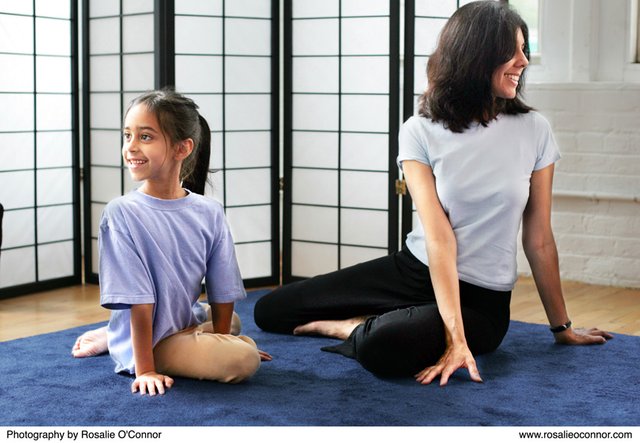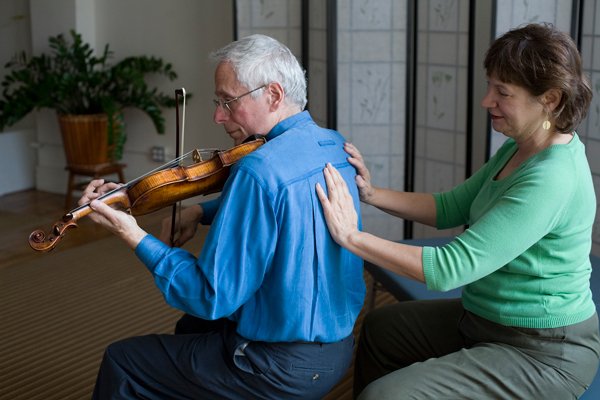The Feldenkrais Method of Somatic Education: An Introduction
What is the Feldenkrais Method®?
The Feldenkrais Method® is a unique approach to improve overall human function through movement. Now, that's not going to mean much to most people. It's a little like trying to explain gravity or electricity, everybody's eyes glaze over two sentences into it, but if you point out their effects, one can begin to develop a notion what it is about. (Wildman)
Describing the Feldenkrais Method through language abstractions is not an easy task; the method is experience based. So before attempting to define the Feldenkrais Method, let me offer a brief experience, so we might “understand one another” better.
Let's try it out!
!( )
)
Below are a few general guidelines, followed by a short movement sequence:
Sit comfortably in a chair, feet resting on the ground.
Repeat each movement slowly, only a few times.
Let your sense of comfort guide you. If you feel discomfort, make the movements smaller and slower.
- Turn your head to the left (letting your eyes look left as well), then return to center. Notice where it feels easy, and where it becomes more difficult to turn.
- Now focus your eyes on a fixed point straight ahead as you turn your head to the left. Return to center.
- Now keep you head stationary in the center, and slowly look to the left with just your eyes. Return to center.
- Now turn you head to the left, and at the same time look to the right with your eyes. Return to center. As you repeat the movement, focus on the details. Can your head and eyes begin and end at the same time? Can you sense places that do not feel smooth?
- Now repeat the first movement, turning you head and your eyes to the left.How is it now? Has the quality of the movement changed? Has the range of the movement changed?
Continue to pay attention to any effects of these movements as we begin to explore the Feldenkrais Method.
Defining the Method
!( )
)
Many practitioners and authors have developed their own working definition of the Feldenkrais Method:
Moshe [Feldenkrais] did not teach a formalized system that can be clearly and unambiguously spelled out. Instead, he taught a broad and revolutionary way of perceiving and understanding human functioning, drawing on his own wide-ranging background and experience. People internalize and apply that way of understanding in ways that match with their own interests, experience, and cognitive styles. (Strauch, 2009)
Although each definition may focus on different aspects of the method, each adds an important piece to the larger puzzle:
“The Feldenkrais Method is an experiential learning system that fundamentally rewires how we move, sense, think and feel” (Questel, 2000, p. 2)
the method “doesn't attempt to cure or heal people but to show them how to learn their way out of limitations and to provide them with the means to continue evolving themselves through a lifetime of continued and pleasurable learning” (Wildman)
“somatic practices such as the Feldenkrais method…seek to integrate the effect of mind on body, and of body on mind, to cultivate a consciously aware bodymind, and more healthful patterns of functioning” (Hartley, 2004, p. 50)
I am developing my own definition of the Feldenkrais Method incorporating depth psychology, adding my piece to the puzzle.
In my working definition, the Feldenkrais Method primarily focuses on learning and awareness. The principles of the method explore the mind-body connection through gentle, easy movements. The purpose of a Feldenkrais lesson is more focused on learning about yourself through examining the process of movement, as opposed to achieving a movement. An element of mindfulness is present in each lesson, for both the practitioner and the client. While developing his method, Feldenkrais
realized along the way...that not only is there a relationship between the mind and the body, the spirit and the somatic, but that basically the person is always whole….If you put your hand on someone you can say ‘I am touching Mark’s arm’ but you are in fact touching the whole person. I am touching his experience, the way he feels about himself, the way he uses his arms. (Joly, 1989, p. 3)
With continued participation in Feldenkrais lessons, the ability to attend to the finer details of experience become more refined; and with a more refined self-awareness, choice in action becomes possible at every turn. This awareness extends beyond bodily function, affecting mood, emotions, thought processes, and more.
Applications—Awareness through Movement and Functional Integration
!( )
)
The advantage of approaching the unity of mental and muscular life through the body lies in the fact that the muscle expression is simpler because it is concrete and easier to locate. It is also comparably easier to make a person aware of what is happening in the body, and therefore the body approach yields faster and more direct results.(Feldenkrais, 1964/2010b, p. 30)
The short movement sequence above is a brief demonstration of an Awareness Through Movement® (ATM®) lesson. Feldenkrais (1979/2010) said,
“Awareness Through Movement is a learning process that makes self-direction easier and more pleasurable, because it resembles the learning that occurs with growth itself” (p. 67).
In a group ATM lesson, movement explorations are often conducted lying on the ground (to minimize the effect of gravity in order to enhance awareness). However, many ATM lessons also incorporate movements in sitting and standing, allowing a functional exploration of moving in gravity. Students are often prompted to do less than their maximum in order to attend to details of each movement:
the lessons are done as slowly and pleasantly as possible, with no strain or pain whatsoever; the main object is not to receive training in what one knows, but to discover unknown reactions in oneself and thereby learn a better, more congenial way of acting. (Feldenkrais, 1975/2010, p. 72)
As Feldenkrais believed, in order to learn about and change your habits, you must work non-habitually.
The other form of the Feldenkrais Method is called Functional Integration® (FI®). This practice uses the same principles of the ATM lessons, but involves directed touch. FI lessons occur in private sessions in which a practitioner works individually with a client, using a combination of gentle touch and verbal cues. As the practitioner manipulates the body (primarily focusing on the skeleton), new connections within the body are being introduced, leading toward a more functional use of self.
“Both formats are based on Feldenkrais’ theory that movement, especially movement initiated and explored with conscious awareness, generates new information in the form of sensation and perception that the nervous system may use to slowly reorganize itself” (Shane, 1999, p. 271).
In a FI lesson, a Feldenkrais practitioner does not aim to fix anything; through touch and other movement explorations, a Feldenkrais practitioner engages a client in their own learning process.
What do you think?
Have any thoughts you would like to share? Experinces during the mini-ATM lesson that were illuminating? Questions you have? I would love to engage with you about the Feldenkrais Method!
References (APA format)
Feldenkrais, M. (2010a). Bodily expressions. In E. Beringer, (Ed.), Embodied Wisdom: The collected papers of Moshe Feldenkrais (pp. 3-25). San Diego, CA: Somatic Resources. (Original work published in 1964)
Feldenkrais, M. (2010). Awareness through movement. In E. Beringer, (Ed.), Embodied Wisdom: The collected papers of Moshe Feldenkrais (pp. 69-75). San Diego, CA: Somatic Resources. (Original work published in 1975)
Feldenkrais, M. (2010). Man and the world. In E. Beringer, (Ed.), Embodied Wisdom: The collected papers of Moshe Feldenkrais (pp. 59-68). San Diego, CA: Somatic Resources. (Original work published in 1979)
Hartley, L. (2004). Somatic psychology: Body, mind and meaning. London, England: Whurr.
Joly, Y. (1989, February). On Feldenkrais and psychology: A lunchtime lecture. Retrieved from http://en.yvanjoly.com/images/3/39/Feldenk_Psy_lect-eng.pdf
Questel, A. (2000). Creating creativity: Embodying the creative process. (n.p.): Uncommon Sensing.
Shane, P. (1999). Moshe Feldenkrais and Functional Integration. In D. Moss, (Ed.), Humanistic and transpersonal psychology: a historical and biographical sourcebook (pp. 268-275). Westport, CT: Greenwood Press.
Strauch, R. (2009, February 20). Defining the Feldenkrais Method. Retrieved from http://somatic.com/blog/2009/02/defining-feldenkrais/
Wildman, F. (n.d.). An interview with Dr. Frank Wildman. Retrieved from http://www.feldenkraisinstitute.org/interview.html
"…the Feldenkrais Method primarily focuses on learning and awareness. The principles of the method explore the mind-body connection…"
^^^This is my favorite component of the Feldenkrais Method based on my brief experience with it. An it's something that so many people need today. Many have become disconnected from their bodies, and their physical self-awareness has become compromised.
Great introduction! Well done!
Thanks so much! For me, the method has really become a way of looking at life. Its not just about moving easer, but functioning easier in the world, both mind and body. And I have been doing a lot of internal integration of the Feldenkrais Method and my studies in depth psychology. They really say many of the same things, but Feldenkrais mostly approaches through the body, and depth psychology approaches from the mind (including the realm of the unconscious).
Where have you experienced Feldenkrais before? I'm always curious to know all the various places the method pops up. :)
Upvoted
Congratulations @jeska! You have completed some achievement on Steemit and have been rewarded with new badge(s) :
Click on any badge to view your own Board of Honor on SteemitBoard.
For more information about SteemitBoard, click here
If you no longer want to receive notifications, reply to this comment with the word
STOPCongratulations @jeska! You received a personal award!
You can view your badges on your Steem Board and compare to others on the Steem Ranking
Vote for @Steemitboard as a witness to get one more award and increased upvotes!
Keep up the great work @jeska
Upvoted
Hi! This post has a Flesch-Kincaid grade level of 8.4 and reading ease of 60%. This puts the writing level on par with Leo Tolstoy and David Foster Wallace.